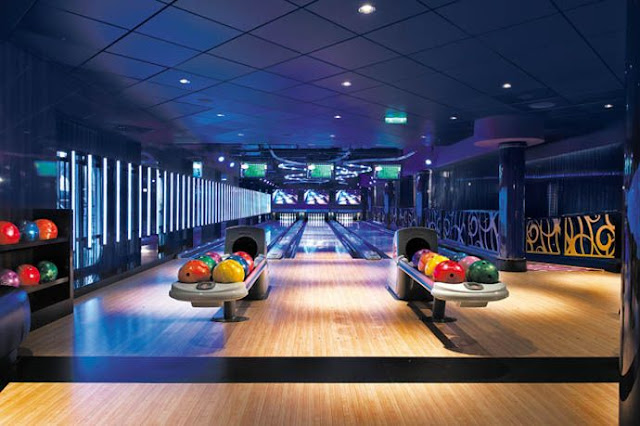The History of bowling in Norway
Bowling, indoor bowling game where one rolls large balls along a course against ten cones at the end of the course. The goal is to roll over as many cones as possible per roll (punch). Played as a recreation or competitive sport in special bowling halls with automatic skittles and automatic return of the balls.
Bowling is a very old game and is today one of the most popular sports in the world. It is estimated that at least 100 million bowls are played today. Here we have made an attempt to give a brief overview of the history of bowling, from the very beginning.
Bowling was considered one of the 90's sports and had progress in Norway towards the end of this decade. Still, skittles play is a game of ancestry, and is known from ancient Egypt and up through history up to our days.
The history of bowling goes back as far as 3200 BC In an Egyptian children's tomb of this time, discovered by British anthropologist Sir Flinders Petrie in the 1930s, a collection of objects was found, among others. stone balls and tapered stone cones, which in his opinion have been used for a simple form of bowling.
In addition, there is also evidence that the Greeks and Romans played bowling around the year 2000 BC. After this, until around the year 300 AD. before again, there are signs of bowling. In 1909 the German historian William Pehle was the first to write in more detail about bowling and the history of the game. He believes that the bowling game began in Germany just around the year 300 AD.
In England, there is concrete evidence that some form of bowling was popular in the 1300s. In 1366, King Edward III reportedly forbade his soldiers to play bowling, so that they would rather concentrate on the obligatory training as archers rather than bowling. He himself built a skating rink in the park at the castle for use by his family and others at the court. Moreover, it is almost certain that the bowling game was popular during Henry VIII's reign. 스포츠토토.me There are incisions with the king busy with skittles, which he had time for outside the courtesy of his many wives. In an old speech, considered by historians as credible, it is said that Sir Francis Drake was delayed in his counter-attack on the Spanish Armada because he had to end a series of bowling.
English, Dutch, and perhaps especially German emigrants have undoubtedly imported their variants of the game to America. New York's "German Quarter" may perhaps be called the Mecca of Bowling in the late 1800s. The earliest mention of bowling in the more serious American literature is by author Jonathan Swift, as his novelist Washington Irwing wakes to the sound of falling cones.
The first permanent US bowling venue was perhaps "lawn bowling" in the New York Battery Area. Today, it is the heart of the financial district, and the New Yorkers still call it Bowling Green.
The game has had its ups and downs in America. A Connecticut law of 1841 prohibited the ownership of "all kinds of nine-cones," probably because bowling was the basis for some gambling. Of course, this problem also proved the popularity of the game. Many industrial magnates nevertheless chose to build their own lanes in their own large houses. The fact that bowling was a game for the upper tier of society shows the fact that it is known that the families of Astor, Vanderbilt, Roosevelt and Styuvesant played regularly in their private clubs.
The first bowling alley in Norway was opened in Bergen in 1960, and Oslo followed in 1961. It was not until the 1960s that the bowling took hold. The background was the invention of the automatic cone travel machine in the late 1950s. By the way, these are basically the same principles that are followed in today's machines, though with more modern technology. Still, the machines work well in today's halls, although some of them were installed in the 1960s. In the 1990s, data has made bowling more accessible to the public and an important threshold has been passed with today's automatic score calculation. The score calculation is displayed on computer screens over the tracks.
Gradually, many bowling alleys have come around Norway and the number is now approaching 100 (2002). The number is also rising rapidly with the opening of new halls in new parts of the country. Although bowling as an active sport is not among Norway's most widespread, this has become a very big corporate sport. Nationally, bowling ranks # 4 in corporate sports. Bowling has also become a very popular leisure activity for many who visit Norwegian bowling alleys from time to time.
Bowling is a very old game and is today one of the most popular sports in the world. It is estimated that at least 100 million bowls are played today. Here we have made an attempt to give a brief overview of the history of bowling, from the very beginning.
Bowling was considered one of the 90's sports and had progress in Norway towards the end of this decade. Still, skittles play is a game of ancestry, and is known from ancient Egypt and up through history up to our days.
The history of bowling goes back as far as 3200 BC In an Egyptian children's tomb of this time, discovered by British anthropologist Sir Flinders Petrie in the 1930s, a collection of objects was found, among others. stone balls and tapered stone cones, which in his opinion have been used for a simple form of bowling.
In addition, there is also evidence that the Greeks and Romans played bowling around the year 2000 BC. After this, until around the year 300 AD. before again, there are signs of bowling. In 1909 the German historian William Pehle was the first to write in more detail about bowling and the history of the game. He believes that the bowling game began in Germany just around the year 300 AD.
In England, there is concrete evidence that some form of bowling was popular in the 1300s. In 1366, King Edward III reportedly forbade his soldiers to play bowling, so that they would rather concentrate on the obligatory training as archers rather than bowling. He himself built a skating rink in the park at the castle for use by his family and others at the court. Moreover, it is almost certain that the bowling game was popular during Henry VIII's reign. 스포츠토토.me There are incisions with the king busy with skittles, which he had time for outside the courtesy of his many wives. In an old speech, considered by historians as credible, it is said that Sir Francis Drake was delayed in his counter-attack on the Spanish Armada because he had to end a series of bowling.
English, Dutch, and perhaps especially German emigrants have undoubtedly imported their variants of the game to America. New York's "German Quarter" may perhaps be called the Mecca of Bowling in the late 1800s. The earliest mention of bowling in the more serious American literature is by author Jonathan Swift, as his novelist Washington Irwing wakes to the sound of falling cones.
The first permanent US bowling venue was perhaps "lawn bowling" in the New York Battery Area. Today, it is the heart of the financial district, and the New Yorkers still call it Bowling Green.
The game has had its ups and downs in America. A Connecticut law of 1841 prohibited the ownership of "all kinds of nine-cones," probably because bowling was the basis for some gambling. Of course, this problem also proved the popularity of the game. Many industrial magnates nevertheless chose to build their own lanes in their own large houses. The fact that bowling was a game for the upper tier of society shows the fact that it is known that the families of Astor, Vanderbilt, Roosevelt and Styuvesant played regularly in their private clubs.
Norway
The first bowling alley in Norway was opened in Bergen in 1960, and Oslo followed in 1961. It was not until the 1960s that the bowling took hold. The background was the invention of the automatic cone travel machine in the late 1950s. By the way, these are basically the same principles that are followed in today's machines, though with more modern technology. Still, the machines work well in today's halls, although some of them were installed in the 1960s. In the 1990s, data has made bowling more accessible to the public and an important threshold has been passed with today's automatic score calculation. The score calculation is displayed on computer screens over the tracks.
Gradually, many bowling alleys have come around Norway and the number is now approaching 100 (2002). The number is also rising rapidly with the opening of new halls in new parts of the country. Although bowling as an active sport is not among Norway's most widespread, this has become a very big corporate sport. Nationally, bowling ranks # 4 in corporate sports. Bowling has also become a very popular leisure activity for many who visit Norwegian bowling alleys from time to time.




Hey! I just noticed one other message in one other weblog that looked like this. How are you aware all this stuff? That’s one cool post. 토토
ReplyDeleteI admire your work , thankyou for all the interesting posts. 파워볼
ReplyDeleteI like the helpful information you provide in your articles. I will bookmark your weblog and check again here regularly. I am quite certain I will learn lots of new stuff right here! Best of luck for the next! 토토
ReplyDelete